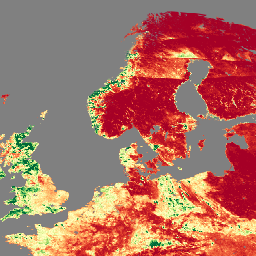
- Disponibilidade de conjuntos de dados
- 2012-01-17T00:00:00Z–2025-12-19T00:00:00Z
- Provedor de conjunto de dados
- NASA LP DAAC no USGS EROS Center
- Cadência
- 8 dias
- Tags
Descrição
O produto de dados do índice de área foliar (LAI) e da fração de radiação fotossinteticamente ativa (FPAR) da Visible Infrared Imaging Radiometer Suite (VIIRS), versão 1, fornece informações sobre a camada de cobertura vegetal com resolução de 500 metros (VNP15A2H). O sensor VIIRS está localizado a bordo do satélite Suomi NPP (Suomi National Polar-Orbiting Partnership), uma parceria conjunta da NOAA/NASA. O LAI é um índice que quantifica a área foliar unilateral de uma copa, enquanto o FPAR é a fração da energia solar recebida absorvida pela fotossíntese em 400 a 700 nanômetros. Esse produto foi projetado intencionalmente com base no algoritmo operacional LAI/FPAR do espectrorradiômetro imageador de resolução moderada (MODIS) do Terra e do Aqua para promover a continuidade da missão do Sistema de Observação da Terra (EOS, na sigla em inglês).
Documentação:
Bandas
Tamanho do pixel
500 metros
Bandas
| Nome | Unidades | Tamanho do pixel | Descrição | ||||||||||||||||||||||||||||||||||||||||||||||||||||||||||||||||||||||||||||||||||||||||||||||||
|---|---|---|---|---|---|---|---|---|---|---|---|---|---|---|---|---|---|---|---|---|---|---|---|---|---|---|---|---|---|---|---|---|---|---|---|---|---|---|---|---|---|---|---|---|---|---|---|---|---|---|---|---|---|---|---|---|---|---|---|---|---|---|---|---|---|---|---|---|---|---|---|---|---|---|---|---|---|---|---|---|---|---|---|---|---|---|---|---|---|---|---|---|---|---|---|---|---|---|---|
Fpar |
metros | Fração da radiação fotossinteticamente ativa. |
|||||||||||||||||||||||||||||||||||||||||||||||||||||||||||||||||||||||||||||||||||||||||||||||||
FparExtra_QC |
metros | Controle de qualidade (QC) de transferência para FPAR |
|||||||||||||||||||||||||||||||||||||||||||||||||||||||||||||||||||||||||||||||||||||||||||||||||
FparLai_QC |
metros | Qualidade para LAI e FPAR |
|||||||||||||||||||||||||||||||||||||||||||||||||||||||||||||||||||||||||||||||||||||||||||||||||
FparStdDev |
metros | Desvio padrão de FPAR |
|||||||||||||||||||||||||||||||||||||||||||||||||||||||||||||||||||||||||||||||||||||||||||||||||
Lai |
Fração da área | metros | Índice de área foliar |
||||||||||||||||||||||||||||||||||||||||||||||||||||||||||||||||||||||||||||||||||||||||||||||||
LaiStdDev |
Fração da área | metros | Desvio padrão para LAI |
||||||||||||||||||||||||||||||||||||||||||||||||||||||||||||||||||||||||||||||||||||||||||||||||
Termos de Uso
Termos de Uso
Os dados da NASA do LP DAAC são de livre acesso. No entanto, quando um autor publica esses dados ou trabalhos baseados neles, é necessário citar os conjuntos de dados no texto da publicação e incluir uma referência a eles na lista de referências.
Citações
Acesse a página "Como citar nossos dados" do LP DAAC para informações sobre como citar conjuntos de dados do LP DAAC.
DOIs
Explore com o Earth Engine
Editor de código (JavaScript)
var dataset = ee.ImageCollection('NASA/VIIRS/002/VNP15A2H') .filter(ee.Filter.date('2022-11-01', '2022-12-01')); var visualization = { bands: ['Lai'], min: [0], max: [4], palette: [ 'a50026', 'd73027', 'f46d43', 'fdae61', 'fee08b', 'ffffbf', 'd9ef8b', 'a6d96a', '66bd63', '1a9850', '006837', ] }; Map.setCenter(41.2, 38.84, 3); Map.addLayer(dataset, visualization, 'Leaf Area Index (LAI)');
